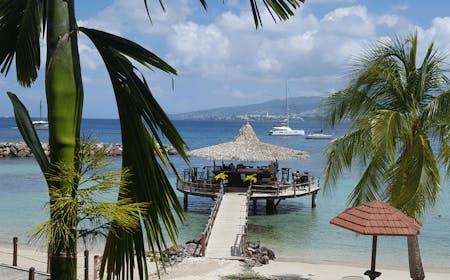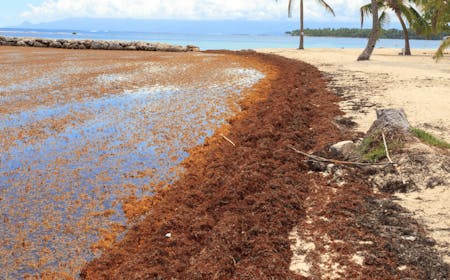
Martinique island : Discovering the island of flowers
The beautiful sandy beaches of the Caribbean Sea is why over half a million visitors flock to the stunning ...
Martinique is undoubtedly a great place to take a break from the winter months. Laying in the Caribbean, this little French island fascinates with its splendid vistas and array of colours. You won’t be disappointed if you chose here as your next travel destination. Therefore, we are going to highlight the top 10 reasons to visit Martinique.
This article is for those who like to be prepared before visiting a destination and would like to know which are the best places to explore. I spent two months in Martinique and so would like to share my experiences with you. Read below to find out all about the coolest tourist attractions!
When it comes to Martinique, you just can’t go wrong with the beaches. The white sand and crystal-clear water are enough to stop you exploring anywhere else! The fact that they’re never jam-packed, and they offer the best spots to sit back and relax is unmissable. Martinique has plenty of beaches. This reason alone is a god enough reason to visit the island.
One of our favorite locations was Anse des Salines, an ideal place for a picnic and a relaxing afternoon nap.
Foodies fly into the French Caribbean to taste the fiery African-Indian, African-French and African-Caribbean smorgasbord of flavours across the islands. Some menus contain fresh seafood, as well as local Creole specialties such as boudin créole (blood sausage), acras (cod fritters), and lambi (conch). With luxurious French restaurants such as Le Belem at Cap Est Lagoon Resort & Spa in Martinique or Le Grand Bleu at La Toubana Hotel on Grand-Terre, one can savor gourmet dishes such as foie gras or roasted duck breast.
The seas around Martinique in the Atlantic Ocean and the Caribbean Sea are brimming with tropical marine life. Snorkelers will see sponges, corals, sea fans, starfish, green sea turtles and brightly coloured fish such as the four-eyed sunshine yellow butterfly in the array of shallower bays, rocky outcrops, coral reefs, and seagrass beds. Divers are drawn to the treasure chest of deep-water sunken ships in Martinique, including 14 vessels sunk by Mt. Pele’s eruption in 1902. The Jacques Cousteau Reserve is a 988-acre diving hotspot in Guadeloupe.
Across the world, Martinique’s rum is known as one of the finest rums in history. You should go on the rum road to explore the distilleries where the liquor is made and purchase a bottle directly from the production line.
Visit the awe-inspiring J.M. distillery founded by Jean-Marie Martin. It is located towards the north of the island, close to the Mount Pelee. It is one of the few that use spring water to make the rum to this day.
The second distillery that you should explore is the St James distillery whilst following the rum road. Located in Saint-Pierre after the 18th century, the location was changed to Sainte Marie following the eruption of the Montagne Pelée in 1902. Despite this, it produces about three million liters of rum per year.
The native Caribe called the island Madinina – it was named Martinique by the French. Both terms mean « flowers » and « more flowers ». Flushes of purple, yellow and orange are everywhere. Every garden is graced by Frangipani, hibiscus, and anthuriums. Resort entrances host flower beds spelling out property names. Once inside, you will certainly find a fresh bouquet in your room — and maybe petals on your pillow if you are lucky!
Almost half of the island is forested and is either a designated national park or another type of protected land. These green spaces are lined by more than 200 miles of conventional footpaths, including some 30 official and well-kept hiking trails marked and ranked by difficulty. Itineraries let you climb through dense mahogany forests or pass through coastal trees to access desolate beaches. Seasonal hikers can hire a guide to climb up Mount Pelée’s steep mountains for two hours, or enjoy a more casual but longer ramble along a section of the north coast that has no access roads.
Fort-de-France’s downtown shops may lure you with the new Parisian creations, but it’s the local artwork and jewelry that makes shopping here so enjoyable. Arrive at the central shopping area between Rue Victor Hugo and Rue Antoine Siger, where some of the finest jewelry shops are beckoned with luminous ornaments. Martinique women enjoy their gold jewelry and a twisted necklace in the chain, gold balls turned into bracelets and fiacre earrings never fail to remain timeless. Delicate metalwork and minor intricacies are trademarks of 18-carat craftsmanship in Martinique.
Saint-Pierre, known as Martinique’s Pompeii, was eventually restored after being devastated by the 1902 eruption of the 4,500-foot Mount Pelée, which killed nearly all of the 30,000 inhabitants of the region.
Tourists visiting the seaside town will see what remains of the devastating — and striking — course of the volcano. Along with a breathtaking view of the sea and mountains, you can see the remnants of both a jail and church that are still standing.
A strange sight welcomes tourists to La Savane Park in Fort-de-France: a defaced monument. Vandals beheaded a marble image of Empress Josephine, Napoleon Bonaparte’s wife, born in Martinique, whilst red blood drips down her empire-waist dress.
Empress Josephine was born into a slave-holding family in Martinique in 1763, and there are some people who seem to have mixed feelings about her island ties. Marie-Josèphe Rose Tascher de la Pagerie, the empress is blamed for persuading her husband to reestablish slavery in 1802. Throughout 1848, the French government eventually abolished slavery and it is not unusual to find people who can trace their origins back to slaves.
La Savane des Esclaves is yet another popular tourist destination on Martinique’s list of best things to visit. This complex is an open-air museum depicting the life of the slaves in reprehensible times in the history of the Caribbean. Slavery in Martinique has been a tradition for decades, and you will learn about all of this historical era on a visit to La Savane des Esclaves.
In addition to the horror stories, this location also provides a demonstration of the life of the first nations living on the Caribbean islands, and displays show the local trees, spices, vegetables and fruits and how they can be used in a kitchen and for medicine.
Here you go, there we have the top 10 reasons why you should visit Martinique! The only thing to do now is to book your plane tickets and start packing your luggage.
I am pretty sure you’ll have a nice holiday in Martinique!
Whether it’s an all-inclusive stay in Martinique or a backpacking journey, it does not matter. You’ll have a wonderful time on the beach relaxing, enjoying fun excursions and drinking tasty rum in this far-off part of France.
Just know that this was just a foretaste of what the island of flowers has to offer! If you want to know more about this precious island, take a look at our blog!
Martinique and its Diamond rock are waiting for you!


The beautiful sandy beaches of the Caribbean Sea is why over half a million visitors flock to the stunning ...

Sargassum is a brown algae, scientifically called sargassum. The deposits can be up to a meter thick and al...

The lobster, just by pronouncing this word, your mouth is watering, at least for those who like shellfish a...